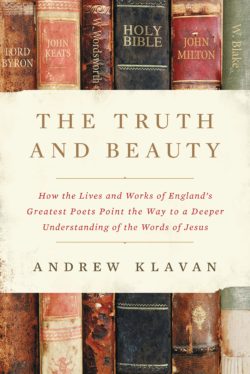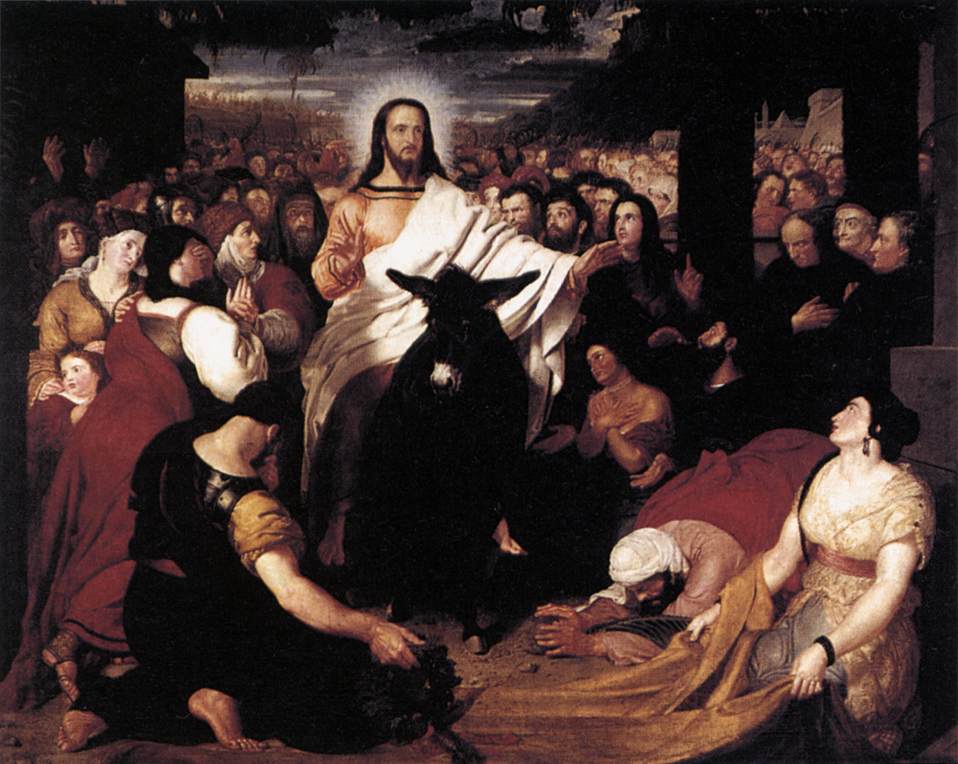
The Truth and Beauty by Andrew Klavan
 Andrew Klavan sums up the general thesis of his latest book, The Truth and Beauty, near its end: “because beauty is truth and truth is beauty, we know our minds are made to find the meaning in creation. Only a human being – his life, his death, his eternal life – can provide us with what Coleridge called the ‘total idea,’ the idea of which each of us expresses his small piece, his soul.” This is a rather lofty sentiment, and one that requires a good amount of both historical and philosophical context to unpack – context which Klavan artfully supplies in the preceding chapters.
Andrew Klavan sums up the general thesis of his latest book, The Truth and Beauty, near its end: “because beauty is truth and truth is beauty, we know our minds are made to find the meaning in creation. Only a human being – his life, his death, his eternal life – can provide us with what Coleridge called the ‘total idea,’ the idea of which each of us expresses his small piece, his soul.” This is a rather lofty sentiment, and one that requires a good amount of both historical and philosophical context to unpack – context which Klavan artfully supplies in the preceding chapters.
Anyone who’s regularly read or listened to Klavan’s body of work (as I have for at least a decade) will tell you that The Truth and Beauty serves well as a companion piece to his articles and monologues on art, the culture, history, and – most importantly – Christ. Where his previous nonfiction work, his memoir The Great Good Thing, told the story of a secular man seeking answers to questions about life, the universe, and everything, questions that brought him anguish and a profound need for a spiritual revelation, The Truth and Beauty gives us an epilogue to that story. This latest book shows a man comfortable in his beliefs who now seeks to answer a simple question: “I believed in the Gospels now. I truly did. But I wanted to know what I believed, what exactly.” From whom did Klavan derive his answer? A bunch of Romantic-era English poets, apparently.
I must admit I am not the most poetically literate man – my appreciation of the art begins and ends with William Shakespeare, Shel Silverstein, and whatever works are referenced by Neil Peart – and at the outset of this book I wasn’t certain I would be able to follow Klavan on this philosophical journey. The prospect of reading a hundred pages about people like Mary Shelley, John Keats, William Wordsworth, and Samuel Taylor Coleridge, among others, in order to better understand the words of Jesus seemed alien to me, but Klavan – in typical fashion – manages to tell an engaging tale about the interwoven lives of all these extraordinary writers while subtly laying the groundwork for a profound exegesis in the final chapter.
Klavan begins with a description of what he calls “The Immortal Evening,” a December dinner held at the home of mediocre painter Benjamin Robert Haydon, which was attended by William Wordsworth, John Keats, and Charles Lamb, among others. This gathering works as a sort of hinge for Klavan’s dive into the lives and works of the aforementioned poets and writers, and his recounting of the evening’s debauchery and banter is a peculiar delight to read. The party actually represents two such hinges, Klavan explains: “Haydon’s painting, Christ’s Entry into Jerusalem, served as a backdrop for the gathering.” The painting included the faces of famous men of the time – including Wordsworth and Keats. “So the poets were there twice that evening, at two of history’s spiritual hinges, once in these London rooms in an era of revolution, and once on the road to Jerusalem, watching Jesus ride past them into the days of his passion.”

The world in which the English romantics found themselves, Klavan asserts, was much like the world in Christ’s time, and indeed like our own today – a time of unbelief. Before digging further into Keats and Wordsworth and their assorted contemporaries, Klavan jumps back to the greatest poet of all time, William Shakespeare, and describes what he calls “the central problem of unbelief,” the simple question: What is truth? Hamlet, Klavan says, demonstrates the issue with clarity: “with unbelief, nothing is certain. Nothing is true. Nothing is either good or bad, but thinking makes it so – as Hamlet says in his performed madness.” Shakespeare identified the issue earlier than most, but the Enlightenment thinkers saw reason and science as the answer. Klavan explains they may have missed the mark, as Mary Shelley demonstrates in Frankenstein.
On another evening, at another gathering of poetic greats, Frankenstein was conceived. Mary Shelley, enraptured at a young age by the poetry of Samuel Taylor Coleridge, had noticed “a tension … between science, with its materialist bias, and women, the conduit for the spiritual life of mankind.” The preindustrial woman, explains Klavan, had many parts to play and many roles to fill, and much of it had begun to be stripped away by Shelley’s time. Much more of it has been today. Klavan states that though the Biblical woman as described by Proverbs 31 is
a font of wisdom, goodness, and charity, she is a powerful economic engine as well. She makes clothes and linens for her own family and then sells the excess at market for a profit. She barters for property and buys it, and then uses her earnings to plant a vineyard on it. And all the while, she rises “while it is yet night” to make sure everyone in her household is fed.
The march of technology and groundbreaking developments in the fields of production and medicine began to diminish the traditional role of women, Klavan explains: “[the Industrial Revolution] is the moment when women’s essential economic contributions began to be undermined, and the integrated social role of spiritual femininity was sundered from women’s physical existence.” Klavan doesn’t purport to have a solution, but the spiritual role of masculinity and femininity — and the Christian God’s demonstration of both in equal measure — is a central thread in his work.
For her part, Mary Shelley, spurred on by the rise of materialism (and with it the declining stature of femininity) and inspired by Coleridge, ghost stories, and the lightning storm enveloping the house she was in that summer night in 1816 with Percy Shelley and Lord Byron, invented science fiction.
From here, Klavan jumps to William Wordsworth, Edmund Burke, John Milton, and an analysis of radicalism, followed by a look at the works and words of Samuel Taylor Coleridge and their profound impact on Wordsworth and Keats. Discussing Wordsworth’s A Whirl-Blast from Behind the Hill, Klavan demonstrates a brilliant capacity to distill the meaning and connotation of Wordsworth’s verse.
The leaves in myriads jump and spring,
As if with pipes and music rare
Some Robin Good-fellow were there,
And all those leaves, in festive glee,
Were dancing to the minstrelsy.In making the leaves jump, the hailstorm creates all the elements of a poem, but it requires a poet, Wordsworth, to see the jumping leaves as a party of fairies dancing to the music of Puck […] in writing the poem, Wordsworth has created all the elements of delight, except for us. We now collaborate with him, by taking his imaginative experience into our minds and making it our own. From nature to Wordsworth to us, it is a chain of collaborative creation by which the forest is filled with fairies.
This “chain of collaborative creation” is central to Klavan’s argument about our connection to nature, and to meaning, and he manages to explain with clarity the transcendent process that occurs when reading an evocative verse.
Klavan goes on to paint a tragic portrait of the life of John Keats, one fraught with despair and a constant striving for greatness he would never achieve in life. All throughout, he deftly sprinkles in breadcrumbs that lead the reader to the idea central to the book and its massive final chapter – “A Romantic Meditation on the Gospels.”
In the book’s introduction, Klavan describes an evening of conversation and whiskey with his son, Spencer – this sort of evening rings very familiar to me, though neither my father nor I would pretend to have had conversations of nearly as intellectual a nature – where he explained his dilemma with the Gospels:
We’re so used to believing these are high moral commandments. They’re the foundation stones of Western civilization, in a way. But would you actually do any of them in real life? Should you do them? Turn the other cheek? If an evil person attacked you, would I stand by with some prissy smile on my face, loving him and not resisting him? Congratulating myself on my piety? […] Does pretending to believe something is good when you can’t live by it realistically – does that even mean anything?
The younger Klavan’s answer was simple: “Maybe the problem is that you are trying to understand a philosophy instead of trying to get to know a man.” So began the elder Klavan’s journey to get to know Jesus. Life, he explains, has meaning, and “Jesus’ life is the meaning of everything.” The Romantics help clarify that connection between life and nature, and between nature and meaning.
Ultimately, the totality of our lives – our perceptions, words, actions – express the whole idea that is our self, our soul. Your soul is not a ghost in a machine; it is a story your life tells. We are just flesh, but flesh is a language, a word; it speaks of a meaning, right or wrong, good or evil, our selves, our souls.
To understand Jesus as both fully a man and fully meaning, Klavan says, was the ultimate goal he was arriving at by studying the Romantics. I can’t say, personally, the the totality of Klavan’s point is completely clear to me, but the many bits of wisdom sprinkled throughout The Truth and Beauty are at once obvious and surprising. Klavan’s story is one that bears re-reading.
One of the central characters of The Truth and Beauty is a hero of Klavan’s, Samuel Taylor Coleridge. Coleridge managed to weave his way in and out of nearly every other mentioned person’s life at one point or another, and often dispensed pearls of understanding so deep, so meaningful as to have a lasting impact on his listeners’ philosophies and works. Coleridge, he explains, would talk in frenzied bursts, jumping from thought to thought with a frantic energy, briefly touching on so many revelations and truths that it was all his listeners could do to keep up and try to absorb a fraction of it.
In The Truth and Beauty, Klavan becomes a Coleridge for the modern age of unbelief. At times meandering, at times somewhat opaque for the non-poetic, but always thought-provoking, always engaging, and – most important – full of truth and beauty.
 The posts are coming!
The posts are coming!


0 comments
Kick things off by filling out the form below.
Leave a Comment